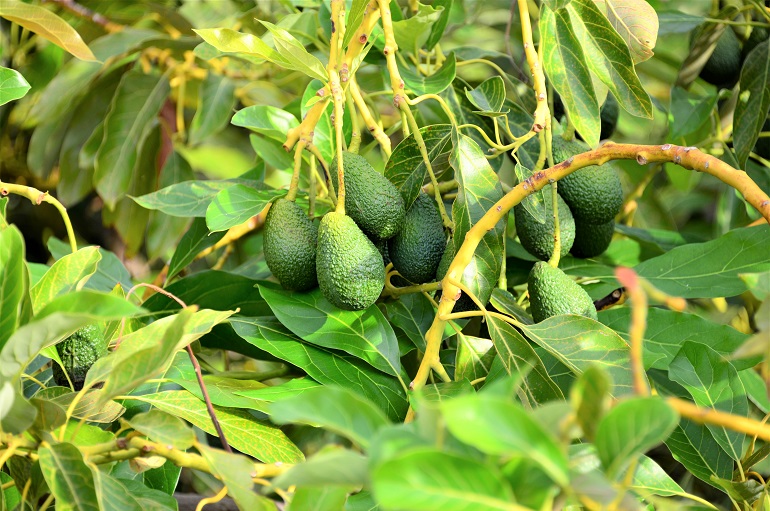Avocado Fertilizer Requirements

This post is also available in:
This post is also available in:
![]() Español (Spanish)
Español (Spanish) ![]() Français (French)
Français (French) ![]() Deutsch (German)
Deutsch (German) ![]() हिन्दी (Hindi)
हिन्दी (Hindi) ![]() العربية (Arabic)
العربية (Arabic) ![]() Türkçe (Turkish)
Türkçe (Turkish) ![]() 简体中文 (Chinese (Simplified))
简体中文 (Chinese (Simplified)) ![]() Ελληνικά (Greek)
Ελληνικά (Greek) ![]() Português (Portuguese (Brazil))
Português (Portuguese (Brazil))
Fertilization in Avocado Farming
To keep the avocado tree vigorous, healthy, and productive, the farmer in some cases may need to cover the crop’s nutrient needs via fertilization. From my experience, avocados do not have a very high demand or great response to fertilizer application in the average soil with no particular deficiencies. However, it is crucial to avoid any nutrient deficiencies and provide the proper nutrients in the amounts needed and at the best time (highest demand from the tree).
Before planting our orchard, we should always perform a soil analysis that will give more information concerning, among others, the soil characteristics (which can affect nutrient availability) and the nutrient reserve. If the trees have already been planted, it is best to simultaneously perform the sampling for soil and leaf analysis (end of the spring/start of winter) and interpret the results together.
To form a specialized fertilization program for avocado trees, we also need to know the type and amount of nutrients removed yearly from our field (e.g., due to harvesting or pruning) and the plant nutrient demand to perform specific processes during the growth cycle, such as flowering.
While nitrogen is the most important since it has a vital role in (shoot) growth and development of the avocado trees, the rest of the nutrients have a critical role. More specifically, Phosphorous is needed for healthy metabolism, Potassium and Zinc are needed for a healthy fruit, Calcium is needed for root growth and fruit quality, Magnesium is needed for improved photosynthesis capacity, and Boron is needed for flowering and fruit set, while Iron and Manganese are also important for plant’s health (1).
More specifically, a yield of 2.7 tonnes (6,000 lbs) can remove approximately 7 kg (16.8 lb) nitrogen (N), (14.6 lb) Phosphorus (P2O5), 18-22 kg (40-48 lb) K2O and more than 2.7 kg (6 lb) of Calcium, Magnesium, Sulfur, and Sodium from the soil (2).
Designing the fertilization program for avocado trees
In rainfed avocado orchards, growers mainly spread the granular fertilizers around the canopy projection before and or/ right after the rainy season (spring). At the same time, in fields with drip irrigation, fertigation is preferred due to the higher precision and efficacy. My avocados grow under irrigation in Crete, Greece, and I choose to fertigate. Fertigation means fertilization and irrigation simultaneously, that is, injection of water-soluble fertilizers in the irrigation system.
To cover the needs of my mature (25 years old) trees (Hass, Zutano, and Fuerte), I use 2 compound fertilizers and apply 1-4 kg per tree annually, broken down into two applications. More specifically, I apply through the drip irrigation system a 20-20-20 (N-P-K) fertilizer in December (mid-winter) and an 18-8-14 (N (NH4NO3)-Κ-Β) in August (end of summer). However, farmers should keep in mind that the actual amounts needed can change with the amount of production and of course the age of the avocado tree.
Type and amount of nutrients needed from young to mature avocado trees
Depending on the soil fertility, the farmer may need to add animal manure six months before planting. Topsoil is mixed with 20 kg per hole of well-decomposed manure and 0.25 kg (0.55 lb) of either Triple Super Phosphate or rock phosphate in the planting hole before refilling (3).
You must avoid any application very close to the planting (before or after) to protect the sensitive young root system from “burning.” Young (non-bearing) trees are usually fertilized every 3 to 6 weeks throughout the growing season (from early spring until early autumn). The amount that can be applied to 1-year-old avocado trees (per tree) annually are:
- 45 g (1.6 oz) N or 150 g (5.3 oz) LAN fertilizer (28% N),
- 21 g P (0.74 oz) or 200 g (7.1 oz) Superphosphate (11.3% P), and
- 75 g (2.6 oz) K or 190 g (6.7 oz) K2SO4 (40% K) (4).
The doses of fertilizers may double in the second year for all nutrients, while other nutrients such as Zinc (Zn) are added. P and K are more important in later growth stages (older trees). For example, as we mentioned above, K is needed in fruits. As a result, in non-productive young trees, the farmer should only include K in the fertilization program when the leaf K range is less than 0.85% by adding 11-45 kg of K2O per hectare (10-40 lb per acre) (5).
The doses of fertilizers will increase until the 12th year of the plant’s life, and from that point onwards, they will remain relatively stable for the following years. Generally, 0.5 – 0.8 kg (1 – 1.8 lbs) actual N, 0.19 kg (0.42 lbs.) P, and 0.75 kg (1.65 lbs) K per mature tree per year may be needed for a good yield. If the farmer wants to use synthetic fertilizer, he/she should choose a product with 1:1:1 or 2:2:1 (N: P: K) proportion (6). Moreover, up to 56 kg per hectare (50 lbs per acre) of Zn may be needed in spring or early summer to correct a nutrient deficiency.
Different varieties have their own nitrogen needs. For example, in leaves of Fuerte, a nitrogen level above 2.0% is associated with reduced yield, whereas in Hass, the same or higher (up to 2.9%) amount is considered ideal (7).
Type of fertilizers and time of application during the season
Avocado trees take up most of their nutrients between full bloom and autumn and during the following spring.
Most of N is taken up by the roots as nitrate (NO3‐) and less as ammonium ( NH₄⁺) (2). The application of urea in avocado orchards is not recommended due to the low uptake ability of the trees. In general, N fertilization is performed from the soil. Still, some references mention that N (urea) foliar spraying to flowers and young leaves has the potential to increase yields and fruit size (5).
Mid to end summer has been suggested as the more appropriate period for applying P and K fertilization, which can boost the growth of the current year and the initiation of next spring’s inflorescences (5). The most commonly used fertilizer types for fertigation using P are Phosphoric acid. K Potassium sulfate, potassium thiosulfate, and potassium nitrate are widely used. It is advised to avoid applying P and Zn fertilizers together with fertigation or using calcium or using phosphoric acid when the irrigation water is rich in magnesium phosphates, since they can chemically react and clog the irrigation system. Foliar applications of K are not so efficient, while for P, scientists have found some positive results in the “off” years (less yield).
Finally, to improve the fruit quality, the farmer can add calcium (Ca) during the first 6 – 8 weeks of fruit growth (8). This can be performed either with:
- foliar application – Ca(NO3)2 at a rate of 100-300 kg/ha split into 2-4 applications, with
- soil application (Gypsum (Ca + S) at a rate of 1-3 tons/ha broadcasted) or
- through fertigation (Buffered Ca (170 g / L, 17 % Ca) can be applied post fruit set at a rate of 7.5 L/ha every 7 – 14 days until harvest) (4).
Lime or dolomite can be added if needed (after soil analysis) once every 2–3 years in very acidic soils to raise the pH and supply the plants with calcium and magnesium. The maximum amount per application is 2 t/ha. If more is needed, you need to split the applications in smaller doses (9).
However, these are just common patterns that should not be followed without doing your own research. Every field is different and has different needs. It is highly recommended to examine the soil and leaf analysis results carefully and consult your local licensed agronomist before applying any fertilization method.
References
- https://www.californiaavocadogrowers.com/sites/default/files/California–avocado–fertilizer–best–practices.pdf
- http://www.avocadosource.com/papers/research_articles/crowleydavidpdf
- https://www.jica.go.jp/project/english/kenya/015/materials/c8h0vm0000f7o8cj–att/materialspdf
- http://redsunhort.co.za/wp–content/uploads/DOWNLOADS/Avo–general–norms–and–fertigation–guidelines.pdf
- https://www.cdfa.ca.gov/is/ffldrs/frep/FertilizationGuidelines/Avocado.html
- https://www.fao.org/3/X6902E/x6902ehtm
- https://ucanr.edu/sites/alternativefruits/files/121293.pdf
- https://www.californiaavocadogrowers.com/cultural–management–library/avocado–tree–fertilization–basics
- https://www.daf.qld.gov.au/business–priorities/agriculture/plants/fruit–vegetable/fruit–vegetable–crops/avocado/planting–and–growing–avocados
History, Nutritional Value and Plant Information of Avocado
All Avocado Varieties Explained- Characteristics and Advantages
Avocado Tree Climate and Soil Requirements – Planting Avocado Trees
Avocado Tree Propagation and Pollination
Avocado Tree Water Requirements and Irrigation Systems
Avocado Fertilizer Requirements
Training and Pruning of Avocado Tree
Avocado Harvest, Yield per hectare and Storage








































































